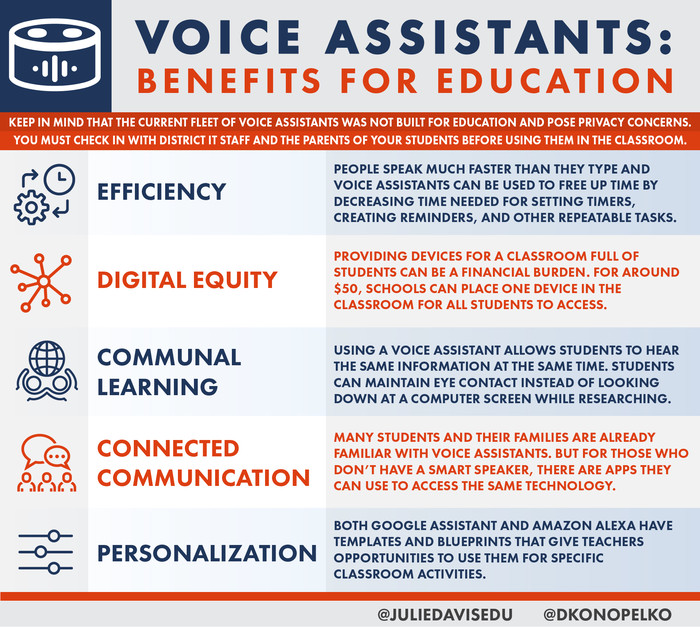In many homes today, scenes from futuristic movies are playing out: A child enters a room and asks it for a weather update, to turn on the TV or to call Mom. Like magic, it happens.
But that “magic” is actually made possible by voice assistant software and conversational artificial intelligence, which are at the core of virtual assistants.
In the U.S., voice assistants include Apple’s Siri, Amazon’s Alexa, Microsoft’s Cortana, Samsung’s Bixby and the Google Assistant. According to Statista, 31 percent of U.S. broadband households own smart speakers with these voice assistants.
Today, they’re also being used for at-home learning. Families are turning their smart speakers into virtual school bells to recreate familiar routines for students and help them stay on schedule with their online learning.
While current voice assistant solutions were not built for education, schools should still keep an eye on this technology. Here’s why.
How Voice Assistants Benefit Teachers and Students
Imagine, if you will, your own personal teaching assistant in the classroom. Think about it: Wouldn’t it be nice to have an assistant to remind you that it’s time to transition to art, or read directions to primary grade students while they’re in a station rotation center?
Voice assistants can take on those tasks and help teachers make their workflow more efficient. Calendar reminders, list-making on the fly, programmed routines and information delivery — without having to pause instruction — can all give teachers a bit more of their most coveted resource: time.
For example, one middle school teacher in Tennessee uses a smart speaker to alleviate the number of basic questions she is asked during class. She found that many of the questions that students would ask could be answered by her Alexa device. So, she started redirecting students to Alexa for those types of questions, which not only freed up more of her time to answer questions only she could answer, but also showed students how to find information on their own.
Other potential benefits of using voice assistants in the classroom include:
- Digital equity: For around $50, schools can place one device in the classroom for all students to access
- Communal learning: Using a voice assistant allows everyone in the classroom to hear the same information at the same time. This means students can maintain eye contact instead of looking down at a computer screen if they need to look up something.
- Connected communication: Many students and their families are already familiar with voice assistants. But for those who don’t have a smart speaker with a voice assistant, there are apps they can use to access the same technology, specifically for Google Assistant and Amazon Alexa.
- Personalization: Both Google Assistant and Amazon Alexa have templates and blueprints that help teachers use them for specific classroom activities.
READ MORE: Learn how AI can revolutionize the K–12 experience for both teachers and students.
Key Considerations When Using Voice Assistants
But before educators add voice assistants to their toolbox, it’s important to remember that today’s popular smart speakers and virtual assistant devices were not made for educational purposes. For this reason, student privacy and data collection should be top of mind for any school staff using voice assistants in the classroom.
Educators who decide to use the devices will have to jump through some hoops to be compliant with student privacy regulations. For example, while the Amazon Echo Dot Kid’s Edition and any Alexa device that has Amazon FreeTime is considered compliant with the Children’s Online Privacy Protection Act, they still need to be set up properly. Teachers need to go through the settings on both platforms and enable features such as “turn off voice learning,” “delete the recordings” and “turn off location services.” They should also get permission from parents and district IT staff before using a voice assistant and explain how they plan to leverage it in the classroom.
Additionally, IT professionals should keep in mind that voice assistants on the market today may not work well — if at all — on a school district network because they were made for consumer use. They should also be aware of the latest updates voice assistant companies are making to help users feel more comfortable with companies’ use and knowledge of users’ personally identifiable information. For instance, Google recently sent out an email to Google Assistant owners to let them know they will no longer be storing voice recordings unless users opt in for that. This move toward transparency and trust is the type of change we need to see in order for this technology to break into education and have a larger impact.
There’s no denying that voice assistants and conversational AI are playing an increasingly important role in our personal lives and will soon find their way into other areas, including education. Educators can either sit back and watch this play out or become active in how it will impact student learning. By speaking into the space of voice technology, educators can ensure it is adapted for the educational realm. To quote a meaningful bumper sticker, educators need to “be a voice, not an echo.”












